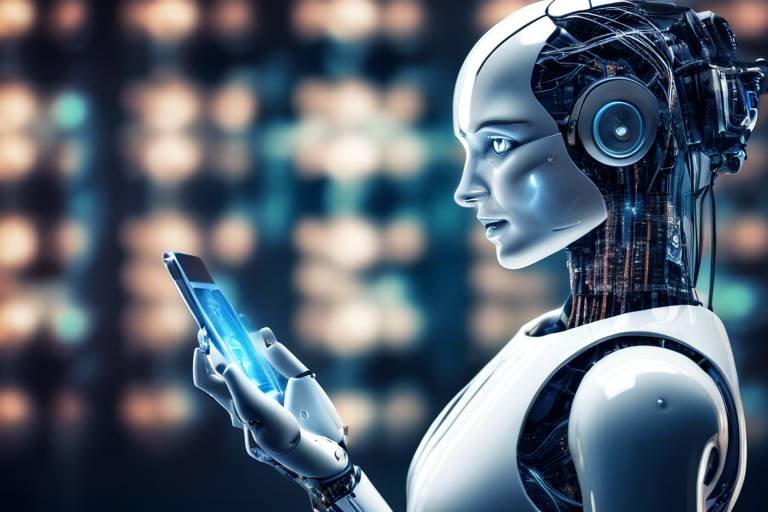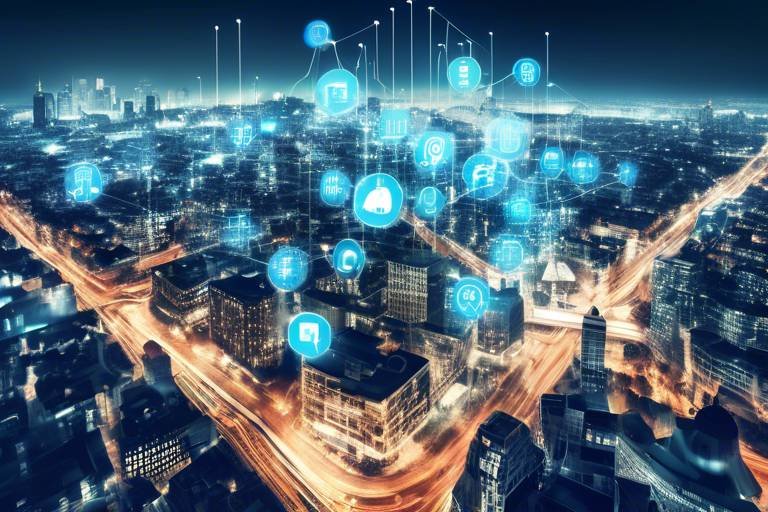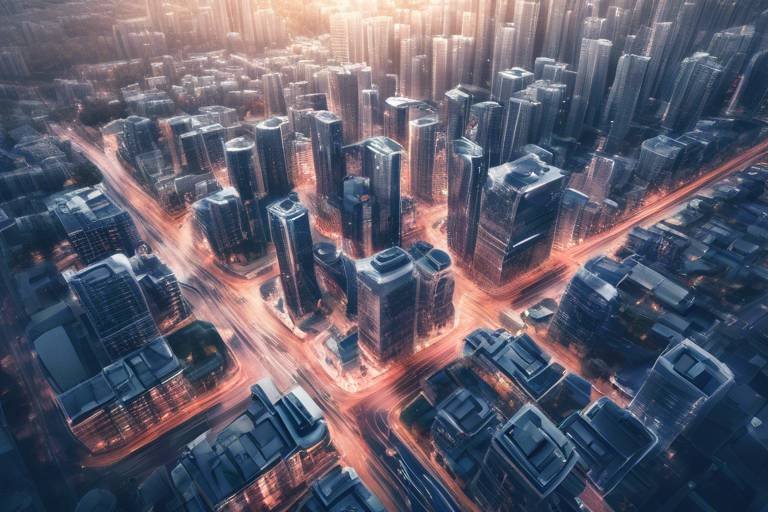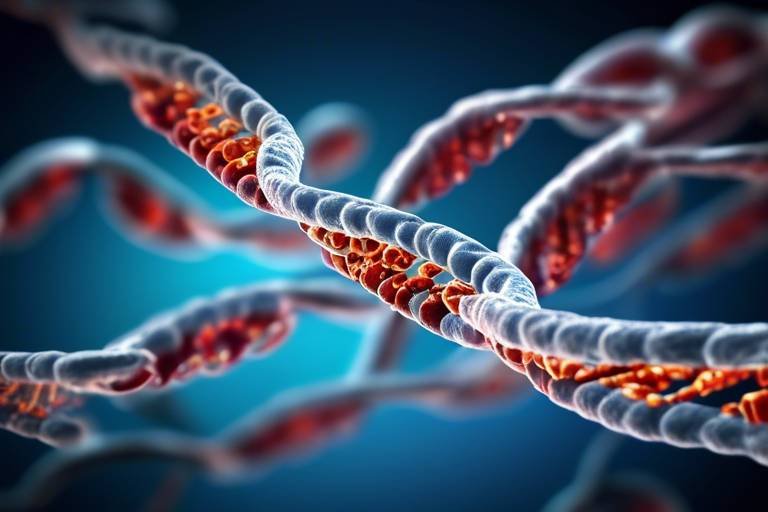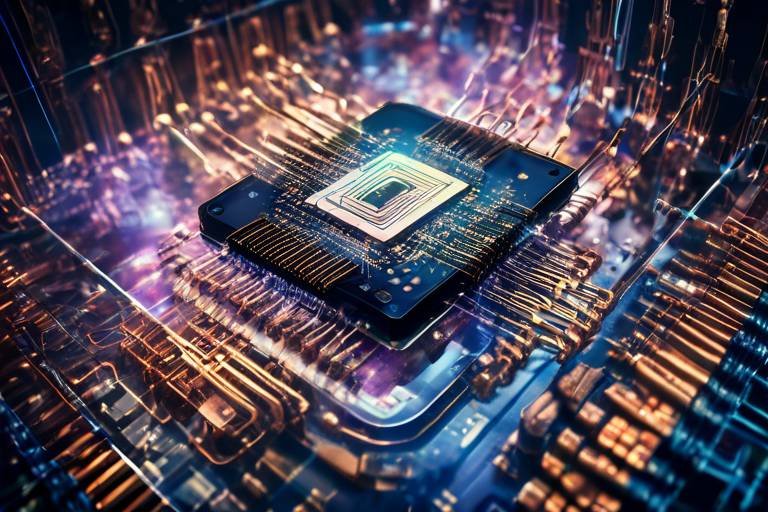How is AI Helping Combat Climate Change?
The battle against climate change is one of the most pressing issues of our time, and it’s a challenge that requires innovative solutions. Enter artificial intelligence (AI), a powerful ally that is transforming how we approach environmental sustainability. From optimizing energy consumption to enhancing climate predictions, AI is making waves in various sectors, helping us tackle climate change more effectively than ever before.
Imagine a world where our energy systems are not only efficient but also intelligent. AI technologies are stepping in to analyze and manage energy use, ensuring that renewable sources like solar and wind power are utilized to their fullest potential. By predicting energy demands and adjusting supply accordingly, AI is paving the way for a greener future. It's like having a personal assistant for our planet, constantly working behind the scenes to optimize our resources and reduce carbon footprints.
Moreover, AI is revolutionizing the way we model and predict climate patterns. With its ability to process vast amounts of data, AI enhances our understanding of climate dynamics, allowing scientists to make more accurate forecasts. This is crucial for developing effective strategies to mitigate the impacts of climate change. Think of it as a weather app on steroids—one that not only tells you if it’s going to rain but also predicts how rising temperatures could impact your local ecosystem.
As we dive deeper into this topic, we'll explore various applications of AI in combating climate change, including its role in renewable energy optimization, climate modeling, and sustainable agricultural practices. But before we get into the nitty-gritty, let’s take a moment to appreciate the incredible potential of AI in reshaping our relationship with the environment.
Artificial intelligence plays a crucial role in optimizing renewable energy sources, improving efficiency, and managing energy distribution. By analyzing data from various sources, AI can predict energy demand and supply fluctuations, leading to a significant reduction in carbon emissions and enhanced sustainability. In fact, studies have shown that AI can improve energy efficiency by up to 30% in certain applications.
One of the most exciting aspects of AI in renewable energy is its ability to integrate with smart grids. These advanced systems use AI algorithms to balance energy loads, forecast energy production from renewable sources, and even store energy for later use. This means that on a sunny day, when solar power generation is high, the excess energy can be stored and utilized when the sun isn’t shining. It’s a seamless dance of energy management that keeps our planet in mind.
AI enhances climate modeling by analyzing vast datasets that were previously too complex for traditional methods. This improved accuracy in climate predictions enables better preparedness for climate-related events. With AI, researchers can simulate different climate scenarios, helping policymakers make informed decisions that can mitigate adverse effects.
AI technologies streamline the collection and analysis of environmental data, enabling researchers to identify trends and patterns that inform climate action strategies and policies. For instance, AI can analyze satellite data to monitor deforestation rates or track changes in land use. This information is invaluable for developing targeted interventions that address specific environmental challenges.
Utilizing satellite imagery and remote sensing, AI can monitor environmental changes in real-time. This capability provides critical insights into deforestation, urbanization, and other factors impacting climate change. By harnessing this technology, we can respond more quickly to environmental threats, much like a fire alarm that alerts us before a small spark turns into a raging inferno.
AI-driven predictive analytics help anticipate climate-related risks and assess the potential impacts of various mitigation strategies. This allows for more informed and timely interventions. For example, cities can use AI to predict flooding events, enabling them to implement measures that protect vulnerable communities. It’s like having a crystal ball that not only sees the future but also helps us navigate it wisely.
AI solutions enhance energy efficiency in buildings and industrial processes, reducing waste and lowering greenhouse gas emissions through smart management systems and predictive maintenance. By using AI to monitor energy consumption patterns, businesses can identify inefficiencies and make necessary adjustments. This not only saves money but also contributes to a healthier planet.
AI technologies are transforming agriculture by optimizing resource use, reducing waste, and promoting sustainable practices that mitigate the environmental impact of farming. With the global population expected to reach 9 billion by 2050, the need for efficient food production is more critical than ever.
AI-driven precision farming techniques enable farmers to optimize inputs such as water and fertilizers, leading to increased yields while minimizing environmental footprints and resource depletion. By analyzing soil data, weather patterns, and crop health, AI helps farmers make data-driven decisions that enhance productivity.
AI systems facilitate real-time monitoring of crop health, allowing farmers to detect issues early and respond accordingly. This proactive approach not only boosts productivity but also reduces the need for harmful pesticides and fertilizers, making agriculture more sustainable. It's akin to having a personal agronomist who is always on call, ready to offer advice and insights.
- How does AI help in reducing carbon emissions? AI optimizes energy use and enhances renewable energy management, leading to lower carbon footprints.
- Can AI predict climate change impacts accurately? Yes, AI improves the accuracy of climate models, enabling better predictions and preparedness.
- What role does AI play in agriculture? AI optimizes resource use in farming, leading to increased efficiency and reduced environmental impact.

AI in Renewable Energy
Artificial intelligence is not just a buzzword; it’s a game-changer in the realm of renewable energy. Imagine a world where energy sources are optimized in real-time, where every solar panel and wind turbine is working at peak efficiency. That’s the power of AI! By analyzing vast amounts of data, AI can predict energy production, manage energy distribution, and even forecast demand, leading to a remarkable reduction in carbon emissions.
Consider this: traditional energy systems often struggle with inefficiencies. However, with AI, we can transform energy management. For instance, AI algorithms can evaluate weather patterns and historical data to predict the best times for energy generation from solar or wind sources. This predictive capability ensures that energy is harnessed when it's most abundant, which is crucial for maximizing renewable energy use.
Moreover, AI enhances the grid management process. Smart grids equipped with AI can adjust to real-time energy demands, ensuring that renewable energy sources are utilized effectively. This not only reduces reliance on fossil fuels but also stabilizes the grid, making it more resilient against fluctuations in energy supply and demand.
Here’s an interesting fact: according to a recent study, AI-driven optimization of energy systems can lead to a reduction of up to 30% in energy costs. This not only benefits consumers but also encourages the adoption of renewable technologies on a larger scale. With AI, we can create a sustainable energy future that is both economically viable and environmentally friendly.
To illustrate the impact of AI in renewable energy, let’s take a look at a comparison of traditional energy management versus AI-enhanced management:
| Aspect | Traditional Energy Management | AI-Enhanced Energy Management |
|---|---|---|
| Efficiency | Moderate | High |
| Cost Reduction | Low | Up to 30% |
| Grid Stability | Vulnerable | Resilient |
| Predictive Capabilities | Limited | Advanced |
In addition to optimizing energy production and distribution, AI also plays a pivotal role in integrating various renewable energy sources. With the rise of decentralized energy systems, where individuals can generate their own energy (think solar panels on rooftops), AI helps coordinate the flow of energy between these sources and the grid. This integration not only maximizes the use of renewable energy but also empowers consumers to take control of their energy consumption.
As we look to the future, the potential of AI in renewable energy is boundless. From enhancing energy storage systems to improving battery management, AI stands at the forefront of innovation. It’s not just about efficiency; it’s about creating a sustainable world where energy is clean, accessible, and abundant for everyone.

Climate Modeling and Prediction
Artificial Intelligence (AI) is revolutionizing the way we understand and predict climate change. Traditionally, climate modeling has been an intricate puzzle, requiring the analysis of vast amounts of data from various sources. However, with AI stepping onto the scene, this daunting task has become more manageable and precise. By leveraging machine learning algorithms, AI can analyze complex datasets at lightning speed, enabling researchers to enhance the accuracy of their climate predictions.
Imagine trying to solve a gigantic jigsaw puzzle with thousands of pieces scattered all over the table. Now, picture having a super-smart assistant who can not only find the pieces faster but also predict how the completed image will look based on the pieces you have. That’s the essence of AI in climate modeling. It helps scientists to not just piece together current climate data, but also to foresee potential future scenarios based on various factors.
One of the most significant advantages of AI is its ability to streamline the collection and analysis of environmental data. By automating the data-gathering process, AI technologies can sift through mountains of information to identify trends and patterns that might otherwise go unnoticed. For instance, AI can analyze historical climate data, satellite imagery, and real-time sensor readings to detect changes in temperature, precipitation, and other critical environmental indicators.
Utilizing remote sensing technologies, AI can monitor environmental changes in real-time. This capability is crucial for understanding phenomena such as deforestation, urbanization, and the melting of polar ice caps. By processing satellite imagery, AI can provide critical insights into how human activities are impacting the planet. For example, a recent study showed that AI algorithms could detect changes in forest cover with over 90% accuracy, allowing for timely interventions to protect vulnerable ecosystems.
Moreover, AI-driven predictive analytics are invaluable for anticipating climate-related risks. Imagine being able to forecast a storm's path or predict a drought's onset weeks in advance. With AI, this is becoming a reality. By analyzing historical weather patterns and current environmental conditions, AI can assess the potential impacts of various mitigation strategies, allowing governments and organizations to make informed and timely decisions. This predictive power is crucial in a world where climate-related disasters are becoming increasingly frequent and severe.
In summary, AI is not just a tool; it's a game changer in the realm of climate modeling and prediction. By enhancing our understanding of climate dynamics and improving our predictive capabilities, AI empowers us to respond more effectively to the challenges posed by climate change. As we continue to harness the power of AI, we can look forward to a future where we are better equipped to protect our planet.
- How does AI improve climate predictions? AI analyzes large datasets quickly and accurately, allowing for better forecasting of climate-related events.
- What role does remote sensing play in climate modeling? Remote sensing provides real-time data about environmental changes, which AI can analyze to track climate impacts.
- Can AI help in disaster preparedness? Yes, AI can predict climate-related risks, enabling better preparedness and response strategies.

Data Collection and Analysis
In the fight against climate change, are paramount. Imagine trying to navigate a dense fog without a map; that’s what tackling climate issues feels like without accurate data. Artificial Intelligence (AI) acts as our guiding light, illuminating the path through massive datasets that would otherwise be impossible to decipher. With the power of machine learning algorithms and sophisticated data analytics, AI can sift through mountains of information, identifying trends and patterns that inform climate action strategies.
One of the most exciting aspects of AI in this realm is its ability to process data from various sources, including weather stations, ocean buoys, and even social media. This multifaceted approach allows for a comprehensive understanding of environmental changes. For instance, AI can analyze satellite imagery to monitor deforestation rates or track urban heat islands, revealing how human activities contribute to climate change.
Moreover, AI enhances data accuracy and speed, enabling real-time analysis that is crucial for timely decision-making. Traditional methods of data collection can be slow and cumbersome, often leading to outdated information. However, with AI, researchers can harness real-time data streams to adjust their models and predictions on the fly. This agility is vital for governments and organizations aiming to implement effective climate policies swiftly.
To illustrate the impact of AI on data collection and analysis, consider the following table, which highlights key AI applications in environmental monitoring:
| AI Application | Description | Benefits |
|---|---|---|
| Satellite Imagery Analysis | Using AI to analyze images from satellites to monitor land use changes. | Provides insights into deforestation and urbanization trends. |
| Predictive Modeling | Using historical data to predict future climate events. | Helps in disaster preparedness and resource allocation. |
| Social Media Monitoring | Analyzing social media data to gauge public sentiment on climate issues. | Informs policymakers about community concerns and priorities. |
AI's role in data collection isn't just about crunching numbers; it's about transforming those numbers into actionable insights. For example, AI can help identify the most vulnerable areas to climate impacts, enabling targeted interventions that can save lives and resources. Imagine a farmer who can predict drought conditions weeks in advance, allowing them to adjust their irrigation practices accordingly. This proactive approach not only conserves water but also enhances crop resilience, demonstrating how AI-driven data analysis can lead to sustainable outcomes.
As we move forward, the integration of AI in environmental data collection and analysis will be crucial. The more we understand our planet's changing dynamics, the better equipped we will be to combat the challenges of climate change. So, the next time you hear about AI in the context of climate action, remember that it's not just about technology; it's about harnessing the power of information to create a more sustainable future.
- How does AI improve climate data accuracy? AI algorithms can analyze vast amounts of data quickly, identifying patterns and anomalies that might be missed by traditional methods.
- What types of data does AI analyze for climate change? AI can analyze data from satellites, weather stations, social media, and more to provide a comprehensive view of environmental changes.
- Can AI predict climate-related disasters? Yes, AI can use historical data to create predictive models that help anticipate events like floods, hurricanes, and droughts.

Remote Sensing Technologies
In the fight against climate change, are proving to be game-changers. Imagine having the ability to monitor the Earth's surface from space in real-time—this is precisely what remote sensing offers. By utilizing satellite imagery and aerial data collection, we can gain invaluable insights into environmental changes that are often invisible to the naked eye. These technologies allow researchers and policymakers to track deforestation, urbanization, and other critical factors that contribute to climate change.
But how does it work? Remote sensing involves capturing data through sensors mounted on satellites or aircraft. These sensors can detect various wavelengths of light, providing information about the Earth's surface and atmosphere. For instance, infrared sensors can identify vegetation health, while thermal sensors can measure surface temperatures. This data is then analyzed using AI algorithms to identify trends and changes over time.
One of the most exciting aspects of remote sensing is its ability to deliver real-time monitoring. This means that as soon as a significant environmental change occurs, stakeholders can be alerted and respond promptly. For example, if a forest is being illegally logged, satellite images can detect this activity almost immediately, allowing for swift action to be taken. This capability is crucial in protecting biodiversity and ensuring sustainable land use.
To illustrate the importance of remote sensing technologies, consider the following table that highlights some of their key applications:
| Application | Description |
|---|---|
| Deforestation Monitoring | Tracks changes in forest cover, allowing for timely interventions. |
| Urban Expansion Analysis | Monitors urban sprawl and its impact on local ecosystems. |
| Climate Change Impact Assessment | Evaluates the effects of climate change on various ecosystems. |
| Disaster Management | Assists in assessing damage and planning recovery efforts post-disaster. |
Furthermore, remote sensing technologies are not just about observation; they also facilitate predictive analytics. By analyzing historical data alongside current observations, AI can model potential future scenarios. This allows governments and organizations to anticipate risks and develop strategies to mitigate them. For example, if a region is prone to flooding, predictive models can help in planning infrastructure improvements to reduce future impacts. The power of remote sensing lies in its ability to transform vast amounts of data into actionable insights, making it an essential tool in combating climate change.
- What is remote sensing? Remote sensing is the process of acquiring information about the Earth's surface using satellites or aircraft equipped with sensors.
- How does AI enhance remote sensing? AI algorithms analyze the data collected from remote sensing to identify patterns, trends, and changes, improving decision-making.
- What are some applications of remote sensing in climate change? Remote sensing is used for monitoring deforestation, assessing urban expansion, evaluating climate change impacts, and aiding in disaster management.
- Can remote sensing help in disaster response? Yes, remote sensing provides real-time data that can be crucial for assessing damage and planning recovery efforts after disasters.

Predictive Analytics
Predictive analytics is like having a crystal ball that allows us to foresee the potential impacts of climate change and the effectiveness of various mitigation strategies. By leveraging artificial intelligence, researchers can analyze historical climate data alongside current trends to forecast future scenarios. This capability is not just about guessing what might happen; it's about making informed decisions that can save lives and resources. Imagine being able to predict a severe weather event days in advance, giving communities the chance to prepare and respond effectively. That's the power of predictive analytics in action!
At its core, predictive analytics uses complex algorithms and machine learning techniques to identify patterns in large datasets. These patterns can reveal critical insights into how climate variables interact and influence one another. For instance, AI can help predict how changes in temperature and precipitation might affect crop yields or water supply in specific regions. This information is invaluable for policymakers and farmers alike, as it enables them to plan ahead and adapt their strategies accordingly.
One of the most exciting aspects of predictive analytics is its ability to simulate the outcomes of various interventions before they are implemented. For example, if a city is considering a new green infrastructure project, AI can model different scenarios to determine which approach would yield the best results in terms of reducing flood risk and improving air quality. This not only saves time and money but also ensures that resources are allocated where they can make the most significant impact.
To illustrate the effectiveness of predictive analytics, consider the following table that outlines some of the key applications and benefits:
| Application | Benefits |
|---|---|
| Climate Risk Assessment | Identifies vulnerable areas and populations, allowing for proactive measures. |
| Disaster Preparedness | Enhances response strategies for extreme weather events. |
| Agricultural Planning | Optimizes planting schedules and resource allocation based on predicted weather patterns. |
| Energy Management | Forecasts energy demand and supply fluctuations, improving grid reliability. |
In essence, predictive analytics acts as a guiding light in the murky waters of climate change. It empowers communities, governments, and businesses to make data-driven decisions that not only mitigate risks but also foster resilience. As we continue to refine these technologies, the possibilities for their application in combating climate change are virtually limitless. So, the next time you hear about a new predictive model, remember that it could be the key to unlocking a more sustainable future.
- What is predictive analytics? Predictive analytics involves using statistical algorithms and machine learning techniques to identify the likelihood of future outcomes based on historical data.
- How does AI improve predictive analytics? AI enhances predictive analytics by processing vast amounts of data quickly and accurately, uncovering complex patterns that might be missed by traditional methods.
- Can predictive analytics help in disaster management? Yes, predictive analytics can forecast extreme weather events and help in planning and response strategies, ultimately saving lives and resources.
- What industries benefit from predictive analytics? Many industries, including agriculture, energy, healthcare, and urban planning, benefit from predictive analytics in various ways.

Improving Energy Efficiency
In a world where energy consumption is constantly on the rise, improving energy efficiency has become a key focus for both businesses and households. Artificial Intelligence (AI) is stepping in as a game-changer, offering innovative solutions that not only save energy but also significantly reduce greenhouse gas emissions. Imagine your home or office operating like a well-oiled machine, where every light, appliance, and system is working in perfect harmony to use energy more wisely. Sounds like a dream, right? Well, with AI, this dream is becoming a reality.
One of the most exciting applications of AI in energy efficiency is through smart management systems. These systems utilize AI algorithms to analyze energy consumption patterns and adjust settings in real-time. For instance, during peak hours, the system can automatically lower the energy usage of non-essential appliances, ensuring that the most critical systems remain operational without overloading the grid. This not only helps in reducing costs but also contributes to a more stable energy supply.
Furthermore, predictive maintenance powered by AI is revolutionizing how we manage energy-consuming equipment. Traditional maintenance schedules often lead to unnecessary downtime and wasted resources. However, AI can analyze the performance data of equipment to predict when maintenance is actually needed, rather than relying on a fixed schedule. This proactive approach minimizes energy waste and extends the lifespan of machinery, which is a win-win for both the environment and the bottom line.
To illustrate the impact of AI on energy efficiency, consider the following table:
| AI Application | Impact on Energy Efficiency |
|---|---|
| Smart Thermostats | Automatically adjust heating and cooling based on occupancy and preferences. |
| Energy Management Systems | Analyze consumption data to optimize energy usage across facilities. |
| Predictive Maintenance | Reduce downtime and energy waste by predicting equipment failures. |
| Smart Grids | Enhance energy distribution efficiency and reduce losses in transmission. |
This table highlights just a few of the ways AI is making a difference. The integration of AI into energy systems is not just about saving a few bucks; it's about creating a sustainable future. By utilizing AI technologies, we can achieve a more efficient energy landscape that benefits everyone.
In addition to these technologies, AI also plays a crucial role in behavioral change. By providing users with insights into their energy usage, AI can encourage more sustainable habits. For example, an AI-powered app can notify users when they are using more energy than usual, prompting them to take action. This kind of feedback loop is essential for fostering a culture of energy conservation.
So, how do we move forward with these advancements? Collaboration between tech companies, governments, and consumers is vital. By investing in AI technologies and promoting their adoption, we can collectively work towards a more energy-efficient future. The journey may seem daunting, but with AI leading the charge, we are certainly on the right path.
- What is energy efficiency? Energy efficiency refers to using less energy to perform the same task or activity, thereby reducing energy waste.
- How does AI improve energy efficiency? AI improves energy efficiency by optimizing energy use, predicting equipment failures, and encouraging sustainable habits among users.
- Can AI help reduce energy costs? Yes, by optimizing energy consumption and reducing waste, AI can lead to significant cost savings for both individuals and businesses.
- What are some examples of AI applications in energy efficiency? Examples include smart thermostats, energy management systems, predictive maintenance, and smart grids.

Sustainable Agriculture Practices
Sustainable agriculture is more than just a buzzword; it's a vital approach to farming that acknowledges the interconnectedness of our environment, economy, and society. With the world's population projected to reach nearly 10 billion by 2050, the pressure on our agricultural systems has never been greater. This is where artificial intelligence (AI) steps in, transforming traditional farming methods into smart, efficient, and eco-friendly practices. Imagine a farm where every drop of water is used wisely, every nutrient is applied precisely, and every decision is data-driven. Sounds futuristic, right? But it's happening now!
AI technologies are revolutionizing agriculture by optimizing resource use, reducing waste, and promoting practices that not only enhance productivity but also mitigate the environmental impacts of farming. For instance, AI algorithms analyze vast amounts of data from various sources, including weather patterns, soil conditions, and crop health, enabling farmers to make informed decisions that lead to sustainable outcomes. This is akin to having a personal assistant who knows the best time to plant, water, and harvest, ensuring that every action is calculated for maximum benefit.
One of the most exciting advancements in sustainable agriculture is precision farming. This approach utilizes AI to tailor farming practices to the specific needs of different areas within a field. By employing technologies such as drones and sensors, farmers can collect real-time data on soil health, moisture levels, and crop growth. This data is then analyzed to determine the optimal amounts of water, fertilizers, and pesticides needed, minimizing waste and reducing the environmental footprint. For example, instead of applying fertilizers uniformly across a field, precision farming allows for targeted application, which can lead to substantial cost savings and reduced runoff into nearby waterways.
Furthermore, AI-driven systems facilitate effective crop monitoring and management. With the help of machine learning algorithms, farmers can track the health of their crops throughout the growing season. These systems can identify early signs of disease or pest infestations, enabling timely interventions that can save entire harvests. Imagine being able to detect a problem before it becomes a crisis—this is the power of AI in agriculture. It empowers farmers to be proactive rather than reactive, ensuring that crops are healthy and yields are maximized.
To illustrate the impact of AI in sustainable agriculture, consider the following table that summarizes key benefits:
| Benefit | Description |
|---|---|
| Resource Optimization | AI helps in precise application of water, fertilizers, and pesticides, reducing waste and improving yields. |
| Enhanced Crop Monitoring | Real-time data collection allows for early detection of diseases and pests, leading to timely interventions. |
| Sustainability | Promotes practices that conserve resources and reduce environmental impact, such as reduced chemical runoff. |
| Increased Efficiency | Data-driven decision-making enhances overall farm management, leading to better productivity and profitability. |
In conclusion, the integration of AI into sustainable agriculture practices is not just a trend; it’s a necessary evolution in how we approach food production. By harnessing the power of technology, farmers can create systems that are not only productive but also environmentally friendly. This shift is crucial for ensuring food security while preserving our planet for future generations. As we continue to innovate and adapt, the possibilities for sustainable agriculture are limitless, paving the way for a greener, healthier world.
- What is sustainable agriculture? Sustainable agriculture refers to farming practices that meet current food needs without compromising the ability of future generations to meet their own needs, focusing on environmental health, economic profitability, and social equity.
- How does AI improve farming? AI improves farming by providing data-driven insights that help farmers optimize resource use, enhance crop monitoring, and make informed decisions that lead to increased efficiency and sustainability.
- What are precision farming techniques? Precision farming techniques involve using technology such as drones and sensors to collect data on crop and soil conditions, allowing for tailored farming practices that improve yields and reduce waste.

Precision Farming
Imagine standing in a vast field, surrounded by rows of crops, each one thriving, and you know exactly why. This is the magic of , a revolutionary approach that harnesses the power of artificial intelligence to optimize agricultural practices. By leveraging cutting-edge technology, farmers can make informed decisions that not only enhance their yields but also protect our precious environment. So, how does this work? Let's dive in!
At its core, precision farming is all about using data to drive decisions. Farmers collect a plethora of information about their crops, soil health, weather patterns, and even pest activity. With the help of AI, this data is analyzed to provide insights that lead to more efficient resource usage. For instance, instead of applying a blanket amount of fertilizer across an entire field, farmers can pinpoint areas that need more nutrients and others that require less. This not only saves money but also minimizes the risk of over-fertilization, which can lead to harmful runoff into nearby waterways.
Moreover, precision farming employs advanced technologies such as drone surveillance and satellite imagery. These tools allow farmers to monitor their fields in real-time, spotting issues before they escalate. Imagine having an eye in the sky that alerts you to a pest outbreak or a drought stress situation in your crops. This proactive approach means that farmers can act swiftly, ensuring that their crops remain healthy and productive.
But that’s not all! AI-powered algorithms can also predict optimal planting and harvesting times based on weather forecasts and soil conditions. This predictive capability helps farmers to align their activities with nature, ensuring that they make the most of every growing season. As a result, the impact on the environment is significantly reduced, as less water and fewer chemicals are wasted.
To illustrate the impact of precision farming, consider the following table that highlights key benefits:
| Benefit | Description |
|---|---|
| Resource Efficiency | Optimizes input usage (water, fertilizers, pesticides) leading to reduced waste. |
| Increased Yields | Data-driven decisions enhance crop productivity and quality. |
| Environmental Protection | Minimizes chemical runoff and promotes sustainable farming practices. |
| Cost Savings | Reduces operational costs by optimizing resource application and management. |
In summary, precision farming is not just a trend; it's a necessary evolution in agriculture. By embracing AI technologies, farmers can cultivate their lands more sustainably while ensuring food security for the growing global population. This approach is akin to having a personal coach for your crops, guiding you to make the best choices for both your farm and the planet.
- What is precision farming? Precision farming is an innovative agricultural practice that uses technology and data analysis to optimize farming activities for better yields and sustainability.
- How does AI contribute to precision farming? AI analyzes vast amounts of agricultural data to provide insights that help farmers make informed decisions about resource usage, pest management, and crop health.
- What technologies are used in precision farming? Technologies such as drones, satellite imagery, soil sensors, and AI-driven analytics are commonly used in precision farming.
- Can precision farming help the environment? Yes, by optimizing resource usage and minimizing waste, precision farming practices can significantly reduce the environmental impact of agriculture.

Crop Monitoring and Management
In the ever-evolving world of agriculture, have become paramount for farmers looking to boost productivity while minimizing their environmental impact. With the help of artificial intelligence, farmers are now equipped with advanced tools that allow them to monitor their crops in real-time, ensuring optimal growth conditions and resource utilization. Imagine having a personal assistant who knows exactly when your plants need water, nutrients, or protection from pests – that’s the power of AI in crop management!
AI systems utilize a combination of satellite imagery, drone technology, and sensor data to provide farmers with a comprehensive view of their fields. These technologies collect vast amounts of data, which AI algorithms analyze to detect patterns and anomalies in crop health. For instance, if a certain section of a field is not receiving enough water, the AI can alert the farmer, who can then take immediate action to rectify the situation. This proactive approach not only enhances crop yields but also conserves precious resources like water and fertilizers.
Moreover, the integration of AI in crop monitoring allows for the implementation of precision agriculture techniques. By leveraging data analytics, farmers can make more informed decisions about when to plant, irrigate, and harvest their crops. This data-driven approach can lead to significant cost savings and increased efficiency. For example, AI can analyze weather patterns to predict the best planting times, ensuring that crops are sown under ideal conditions.
To illustrate the impact of AI in crop monitoring, consider the following table that summarizes key benefits:
| Benefit | Description |
|---|---|
| Real-time Monitoring | Farmers can track crop health and environmental conditions instantly, allowing for quick interventions. |
| Resource Optimization | AI identifies the precise amount of water and nutrients needed, reducing waste and costs. |
| Pest and Disease Management | Early detection of pests and diseases enables targeted treatments, minimizing chemical use. |
| Yield Prediction | AI algorithms can forecast crop yields based on historical data and current conditions, aiding in market planning. |
Additionally, AI-driven crop management systems can facilitate collaborative farming, where multiple farmers share data and insights to enhance their collective output. This community approach not only fosters a sense of camaraderie but also leads to more sustainable farming practices. By pooling resources and knowledge, farmers can tackle challenges like climate change and resource scarcity more effectively.
As we look to the future, the role of AI in crop monitoring and management is set to expand even further. With advancements in machine learning and data analytics, farmers will have access to even more sophisticated tools that can predict and adapt to changing environmental conditions. This evolution is not just about increasing productivity; it’s about creating a more sustainable and resilient agricultural system that can withstand the pressures of climate change.
- How does AI improve crop monitoring? AI enhances crop monitoring by analyzing data from various sources, including satellite imagery and sensors, to provide real-time insights into crop health.
- Can AI help reduce the use of pesticides? Yes! AI can detect pest infestations early, allowing farmers to apply targeted treatments rather than blanket pesticide applications, thus reducing chemical use.
- What is precision agriculture? Precision agriculture is a farming management concept that uses technology and data analysis to optimize field-level management regarding crop farming.
- Is AI in agriculture expensive? While initial investments can be high, the long-term savings and increased yields often justify the costs, making it a worthwhile investment for many farmers.
Frequently Asked Questions
-
How is AI being used in renewable energy?
AI is revolutionizing renewable energy by optimizing the performance of energy sources like solar and wind. It helps in predicting energy production, managing energy distribution, and enhancing the efficiency of energy systems, ultimately leading to a significant reduction in carbon emissions.
-
What role does AI play in climate modeling?
AI enhances climate modeling by analyzing vast amounts of environmental data. This analysis improves the accuracy of climate predictions, allowing scientists and policymakers to better prepare for and respond to climate-related events, ensuring more effective decision-making.
-
How does AI assist in data collection and analysis?
AI technologies streamline the process of collecting and analyzing environmental data. By identifying trends and patterns, AI enables researchers to formulate effective climate action strategies and policies, making it easier to tackle climate change challenges.
-
What are remote sensing technologies and how do they relate to AI?
Remote sensing technologies involve the use of satellite imagery to monitor environmental changes. AI analyzes this data in real-time, providing critical insights into deforestation, urbanization, and other factors that impact climate change, allowing for timely interventions.
-
Can AI predict climate-related risks?
Absolutely! AI-driven predictive analytics can anticipate climate-related risks and assess the potential impacts of various mitigation strategies. This capability allows governments and organizations to make informed and timely decisions to combat climate change effectively.
-
How does AI improve energy efficiency?
AI enhances energy efficiency in buildings and industrial processes through smart management systems that optimize energy use. By implementing predictive maintenance, AI reduces waste and lowers greenhouse gas emissions, contributing to a more sustainable future.
-
What is precision farming and how does AI contribute?
Precision farming uses AI to optimize resource use in agriculture, such as water and fertilizers. This technology enables farmers to increase yields while minimizing their environmental footprint, making agriculture more sustainable and efficient.
-
How does AI assist in crop monitoring and management?
AI systems facilitate real-time monitoring of crop health, allowing farmers to make data-driven decisions. This leads to enhanced productivity and sustainability in agricultural practices, ensuring that resources are used wisely and effectively.







